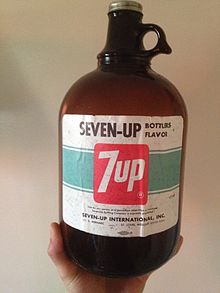Gum syrup

In cooking, syrup (less commonly sirup; from Arabic: شراب; sharāb, beverage, wine and Latin: sirupus)[1] is a condiment that is a thick, viscous liquid consisting primarily of a solution of sugar in water, containing a large amount of dissolved sugars but showing little tendency to deposit crystals. In its concentrated form, its consistency is similar to that of molasses. The viscosity arises from the multiple hydrogen bonds between the dissolved sugar, which has many hydroxyl (OH) groups.
Types

There are a range of syrups used in food production, including:
- Agave syrup, made from agave stem
- Cane syrup, made from sugar canes
- Chocolate syrup
- Corn syrup
- Glucose syrup
- Golden syrup, a by-product of refining crystallized sugar
- High fructose corn syrup, widely used in the US[2][3][4][5]
- Maple syrup
- Table syrup
Uses
For beverages

A variety of beverages call for sweetening to offset the tartness of some juices used in the drink recipes. Granulated sugar does not dissolve easily in cold drinks or ethyl alcohol. Since syrups are liquids, they are easily mixed with other liquids in mixed drinks, making them superior alternatives to granulated sugar.
Simple sugar syrups
Simple syrup
Simple syrup (also known as sugar syrup, or bar syrup) is a basic sugar-and-water syrup. It is used by bartenders as a sweetener to make cocktails, and as a yeast feeding agent in ethanol fermentation.
The ratio of sugar to water is 1:1 by volume for normal simple syrup, but can get up to 2:1 for rich simple syrup.[6] For pure sucrose the saturation limit is about 5:1 (500 grams (18 oz) sucrose to 100 millilitres (3.5 imp fl oz; 3.4 US fl oz) water).
Demerara syrup
Combining demerara sugar, a type of natural brown sugar, with water in this process produces demerara syrup. Sugar substitutes such as honey or agave nectar can also be used to make syrups. Spices can be added to the ingredients during the process, resulting in a spiced simple syrup.
Gomme syrup
Gomme syrup (or gum syrup; gomme is French for "gum") is a boiled mixture of sugar and water, made with the highest ratio of sugar to water possible.[7] In old recipes, gum arabic is added,[8] in the belief that it prevents the sugar from crystallizing and adds a smooth texture.[7] Some recipes omit the gum arabic,[9] thus are just simple syrup, considering the gum undesired,[7] or to reduce cost.[10]
Gomme syrup is an ingredient commonly used in mixed drinks.[7]
In Japan, liquid sweeteners for iced coffee are called gum syrup, although they are actually simple syrup which contains no gum arabic.[11] Ingredients vary by brand; some are glucose–fructose syrup,[12] some are sugar, or blends of both.[13]
Flavored syrup
Flavored syrups are made by infusing simple syrups with flavoring agents during the cooking process. A wide variety of flavoring agents can be used, often in combination with each other, such as herbs, spices, or aromatics. For instance, syrups' aromatics is prepared by adding certain quantities of orange flavorings and cinnamon water to simple syrup. This type of syrup is commonly used at coffee bars, especially in the United States, to make flavored drinks. Infused simple syrups can be used to create desserts, or add sweetness and depth of flavor to cocktails.
Feedstock for fermentation
Glucose syrups rating over 90 DE (dextrose equivalent) are used in industrial fermentation.[14]
Production
Syrups can be made by dissolving sugar in water or by reducing naturally sweet juices such as cane juice, sorghum juice, or maple sap. Corn syrup is made from corn starch using an enzymatic process that converts it to sugars.
A must weight-type refractometer is used to determine the sugar content in the solution.
See also
References
- ^ Online Etymology Dictionary: syrup Archived 2012-08-21 at the Wayback Machine
- ^ Tyler James Wiltgen (August 2007). "An Economic History of the United States Sugar Program" (PDF). Archived (PDF) from the original on 2015-02-09. Masters thesis.
- ^ "U.S. Sugar Policy". SugarCane.org. Archived from the original on 2015-02-11. Retrieved 2015-02-11.
- ^ Schoonover, Heather; Muller, Mark (November 2006). "Food without Thought: How U.S. Farm Policy Contributes to Obesity". Institute for Agriculture and Trade Policy. Archived from the original on 2007-09-27.
- ^ "Corn Production/Value". Allcountries.org. Archived from the original on 2010-10-25. Retrieved 2010-11-06.
- ^ Dietsch, Michael. "Cocktail 101: How to Make Simple Syrup". Serious Eats. Retrieved 1 July 2018.
- ^ a b c d Embury, David A. (1961). "Sugar syrup". The Fine Art of Mixing Drinks (American ed.). New York: Dolphin Books. p. 100. ISBN 978-0-385-09683-6. OCLC 4183957 – via Archive.org.
- ^ Whitehead, Jessup (1903) [1889]. "Gum syrup". The steward's handbook Part first– Hotel stewarding. Chicago: Whitehead & Co. p. 337. hdl:2027/uc1.$b31773. OCLC 612420970 – via Hathitrust.
- ^ Stuart, Thomas (1904). "Gum syrup". Stuart's fancy drinks and how to mix them. New York: Excelsior publishing house. p. 68. LCCN 06046581. OCLC 1157739680 – via Library of Congress.
- ^ Rowley, Matthew (2021). "gum syrup". In Wondrich, David; Rothbaum, Noah (eds.). The Oxford Companion to Spirits and Cocktails. New York: Oxford University Press. p. 339. ISBN 9780190670405 – via Google Books.
- ^ Oguma, Tokio; Akado, Ryoji (1968). "P-29 シュガー・シロップ" [P-29 Sugar syrup]. 喫茶店のメニューブック [Cafe menu book] (in Japanese). Tokyo, Japan: 柴田書店 (Shibata Publishing Co.). p. 53. doi:10.11501/2517173.
- ^ でん粉からできる異性化糖 [High-fructose syrup made from starch]. Agriculture & Livestock Industries Corporation (in Japanese). 2015-01-06. Archived from the original on 2022-12-29. Retrieved 2024-02-27.
アイスコーヒーに加えるガムシロップなどで目にすることができます
[[HFCS] can be found in gum syrup added in iced coffee.] - ^ Sakida Miki (2021-04-23). ガムシロップのカロリーや糖質量はどれくらい?管理栄養士が砂糖との違いを解説 [How much calories and saccharides in gum syrup?]. macaroni (in Japanese). p. 3. Archived from the original on 2024-02-26. Retrieved 2024-02-26.
- ^ Dziedzic, S. Z.; Kearsley, M. W. (1995). Handbook of starch hydrolysis products and their derivatives. London: Blackie Academic & Professional. p. 230. ISBN 0-7514-0269-9.
External links
 The dictionary definition of syrup at Wiktionary
The dictionary definition of syrup at Wiktionary- . Encyclopædia Britannica (11th ed.). 1911.






